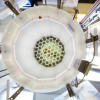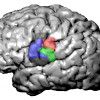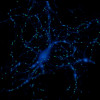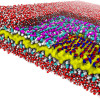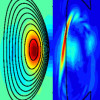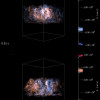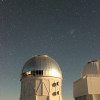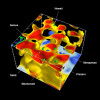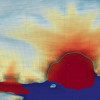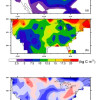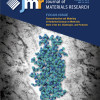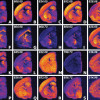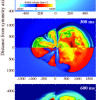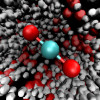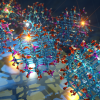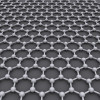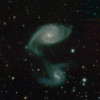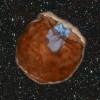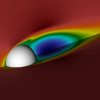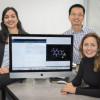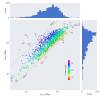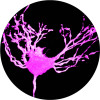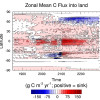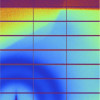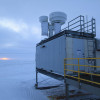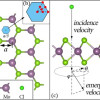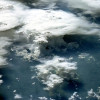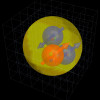Science News
World’s Most Sensitive Dark Matter Detector Gets an Upgrade
The Large Underground Xenon (LUX) dark matter experiment, which operates nearly a mile underground at the Sanford Underground Research Facility, has already proven to be the most sensitive detector in the hunt for dark matter. Now, a new set of calibration techniques employed by LUX scientists has again dramatically improved the detector’s sensitivity. Read More »
NERSC, Berkeley Lab Explore Frontiers of Deep Learning for Science
A collaborative effort at Berkeley Lab is applying deep learning software tools developed for supercomputing environments to “grand challenge” science problems running computations at NERSC. Read More »
Supercomputers Speed Search for New Subatomic Particles
A team of theoretical high-energy physicists in the Fermilab Lattice and MILC Collaborations has published a new high-precision calculation that could significantly advance the indirect search for physics beyond the Standard Model. The calculation applies to a particularly rare decay of the B meson (a subatomic particle), which is sometimes also called a “penguin decay” process. Read More »
‘Sidecars’ Pave the Way for Concurrent Analytics of Large-Scale Simulations
A new software tool developed through a multi-disciplinary collaboration at Berkeley Lab allows researchers doing large-scale simulations at the NERSC and other supercomputing facilities to do data analytics and visualizations of their simulations while the simulations are running. Read More »
New ‘Design Rule’ Paves Way for Nature-Inspired Nanostructures
Berkeley Lab researchers have discovered a design rule that enables a recently created material--peptoid nanosheets--to exist. This never-before-seen design rule could be used to piece together complex nanosheet structures and other peptoid assemblies such as nanotubes and crystalline solids. Read More »
What Causes Electron Heat Loss in Fusion Plasma?
A research team led by Princeton Plasma Physics Laboratory has proposed an explanation for why the hot plasma within tokamaks sometimes fails to reach the required temperature, even as researchers pump beams of fast-moving neutral atoms into the plasma in an effort to make it hotter. Read More »
What Ignites a Neutron Star?
Supercomputers at NERSC helped set the stage for astrophysicists from Stony Brook University, Los Alamos National Laboratory and Lawrence Berkeley National Laboratory to perform the first detailed 3D simulation of an X-ray burst. Read More »
Celeste: A New Model for Cataloging the Universe
A Berkeley Lab-based research collaboration of astrophysicists, statisticians and computer scientists has developed Celeste, a new statistical analysis model designed to enhance one of modern astronomy’s most time-tested tools: sky surveys. Read More »
CT Scan of Earth Links Mantle Plumes with Volcanic Hotspots
University of California, Berkeley, seismologists have produced for the first time a sharp, 3D scan of Earth’s interior that conclusively connects plumes of hot rock rising through the mantle with surface hotspots that generate volcanic island chains like Hawaii, Samoa and Iceland. Read More »
Ice Sheet Model Reveals Most Comprehensive Projections for West Antarctica’s Future
A new international study is the first to use a high-resolution, large-scale computer model to estimate how much ice the West Antarctic Ice Sheet could lose over the next couple of centuries, and how much that could add to sea-level rise. Read More »
Land Management Practices More Critical as Biofuels Use Grows
The handling of agricultural crop residues appears to have a large impact on soil's ability to retain carbon, making land management practices increasingly important, especially under a scenario where cellulosic materials become more heavily used as a feedstock for ethanol production, according to a study led by researchers at the U.S. Department of Energy’s Argonne National Laboratory. “Plants and soil are carbon sinks,” said Argonne climate scientist Beth Drewniak, who led the study. Read More »
Experiments ✚ Simulations = Better Nuclear Power Research
An international collaboration of physicists is working to improve the safety and economics of nuclear power by studying how various cladding materials and fuels used in reactors respond to radiation damage. Read More »
‘Data Deluge’ Pushes Mass Spec Imaging to New Heights
Researchers at Berkeley Lab are working to help the scientific community address emerging data management and analysis issues through MANTISSA (Massive Acceleration New Techniques in Science with Scalable Algorithms), a DOE-funded program that supports the development of novel algorithms that will allow new software tools in a variety of science domains to run at scale on current and next-generation supercomputers. Read More »
The Rise and Fall of Core-Collapse Supernovae
A research team from Oak Ridge National Laboratory (ORNL), University of Tennessee, Florida Atlantic University and North Carolina State University compared 3D models run at ORNL with 2D models run at NERSC to shed new light on the explosion mechanism behind core-collapse supernovae. Read More »
Unravelling the Mysteries of Carbonic Acid
Blink your eyes and it’s long gone. Carbonic acid exists for only a tiny fraction of a second when carbon dioxide gas dissolves in water before changing into a mix of protons and bicarbonate anions. Despite its short life, however, carbonic acid imparts a lasting impact on Earth’s atmosphere and geology, as well as on the human body. However, because of its short lifespan, the detailed chemistry of carbonic acid has long been veiled in mystery. Researchers with Berkeley Lab and the Univ. of… Read More »
What the Blank Makes Quantum Dots Blink?
Quantum dots (shown here dissolved in liquid under ultraviolet light) offer tantalizing prospects for new technologies if scientists can stop them blinking. (Photo by Antipoff, CC BY-SA 3.0) Quantum dots are nanoparticles of semiconductor that can be tuned to glow in a rainbow of colors. Since their discovery in the 1980s, these remarkable nanoparticles have held out tantalizing prospects for all kinds of new technologies, ranging from paint-on lighting materials and solar cells to quantum… Read More »
Spiraling Laser Pulses Could Change Nature of Graphene
A new study that involved large-scale simulations run at NERSC predicts that researchers could use spiraling pulses of laser light to change the nature of graphene, turning it from a metal into an insulator and giving it other peculiar properties that might be used to encode information. Read More »
NERSC Hosts Digital Stargazing Portal
Even non-scientists can now browse sky survey images hosted at NERSC. The DECam Legacy Survey has published the first in a series of web-based catalogs that will offer an update to images of the night sky originally taken with the 15-year-old camera of the Sloan Digital Sky Survey. In the spirit of the new information age, the survey will share frequent updates on its public website. Read More »
Meraculous: Deciphering the ‘Book of Life’ With Supercomputers
A team of scientists from Berkeley Lab, JGI and UC Berkeley, simplified and sped up genome assembly, reducing a months-long process to mere minutes. This was primarily achieved by “parallelizing” the code to harness the processing power of supercomputers, such as NERSC’s Edison system. Read More »
Supernova Hunting with Supercomputers
Using a “roadmap” of theoretical calculations and supercomputer simulations performed at NERSC by Berkeley Lab’s Daniel Kasen, astronomers observed for the first time a flash of light caused by a supernova slamming into a nearby star, allowing them to determine the stellar system from which the supernova was born. This finding confirms one of two competing theories about the birth of Type Ia supernovae. Read More »
Chombo-Crunch Sinks Its Teeth into Fluid Dynamics
Berkeley Lab scientists are breaking new ground in the modeling of complex flows in energy and oil and gas applications, thanks to a computational fluid dynamics and transport code dubbed “Chombo-Crunch.” Read More »
Electrolyte Genome Could Be Battery Game-Changer
The Materials Project hosted at NERSC is taking some of the guesswork out of discovering new battery catalysts with the Electrolyte Genome. Read More »
Expanding the World’s Largest Database of Elastic Properties
Berkeley Lab scientists, using the infrastructure of the Materials Project and NERSC supercomputing resources, have calculated the complete elastic properties for 1,181 inorganic compounds. Read More »
BigNeuron: Unlocking the Secrets of the Human Brain
To find a standard 3D neuron reconstruction algorithm, BigNeuron will sponsor a series of international hackathons and workshops where contending algorithms will be ported onto a common software platform to analyze neuronal physical structure using the same core dataset. All ported algorithms will be bench-tested at NERSC, ORNL and Human Brain Project supercomputing centers.
Read More »
In Climatic Tug of War, Carbon From Thawing Permafrost Wins
New computer simulations conducted at NERSC by Berkeley Lab scientists are the first to represent permafrost processes as well as the dynamics of carbon and nitrogen in the soil. Read More »
Organic Photovoltaics Experiments Showcase ‘Superfacility’ Concept
A collaborative effort linking the Advanced Light Source at Berkeley Lab with supercomputing resources at NERSC and the Oak Ridge Leadership Computing Facility via ESnet is yielding exciting results in organic photovoltaics research that could transform the way researchers use these facilities and improve scientific productivity in the process. Read More »
First Direct Observation of Carbon Dioxide’s Increasing Greenhouse Effect at Earth’s Surface
Researchers from Berkeley Lab have observed an increase in carbon dioxide’s (CO2) greenhouse effect at the Earth’s surface for the first time. They attributed this upward trend to rising CO2 levels from fossil fuel emissions. Read More »
New Algorithm Enables Faster Simulations of Ultrafast Processes
The algorithm opens the door for efficient real-time simulations of ultrafast processes and electron dynamics, such as excitation in photovoltaic materials and ultrafast demagnetization following an optical excitation. Read More »
What Makes Clouds Form, Grow and Die?
Until recently, computer models for simulating climate on a global scale relied on mathematical formulas to approximate how clouds were born and grew. The advent of more advanced computers has enabled researchers to explicitly simulate large-cloud systems instead of approximating them. Read More »
Pinpointing the Magnetic Moments of Nuclear Matter
Using NERSC's Edison supercomputer, a team of nuclear physicists has made a key discovery in its quest to shed light on the structure and behavior of subatomic particles. Read More »






